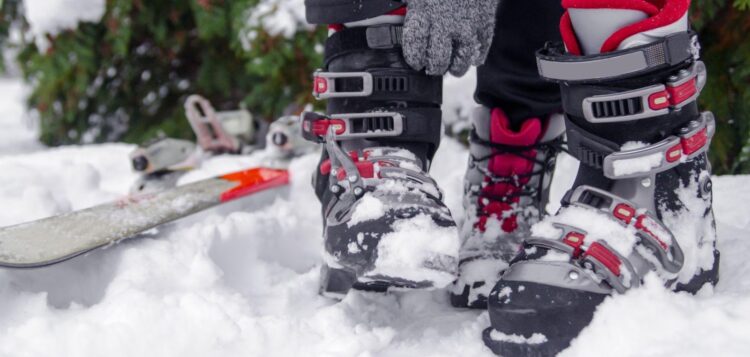When buying ski boots, there are many factors ski boots, but the most important one is finding a pair that fits your foot type. Ski boots are not like regular shoes- they need to be snug enough to hold your foot in place while skiing but not too tight or uncomfortable. This post will outline the different types of feet and suggest some ski boots that will work well for each. So read on to find out which type of ski boot is right for you!
There are three main foot types – neutral, pronated, and supinated.
People fall into one of three categories regarding the shape of their feet – neutral, pronated, or supinated. Neutral feet are relatively straight, with a moderate arch and little to no inward or outward roll. Pronated feet have a low arch and roll inward excessively (sometimes known as “flat feet”). Supinated feet have a high arch and roll outward excessively. While most people fall into one of these categories, it’s important to note that there is plenty of variation within each type. In addition, foot shape can change over time, so it’s vital to re-evaluate your foot type regularly.
Knowing your foot type can be helpful when choosing shoes, as some shoes are best suited for different types of feet. For example, pronated feet often benefit from shoes with extra support and cushioning, while supinated feet often benefit from shoes with firmer soles. For people who have wide feet must go for ski boots for wide feet. However, ultimately the best shoe is the one that feels comfortable to you – so don’t get too bogged down in the details. Just find a shoe that feels good, and you’ll be good to go!
Each foot type requires a different ski boot type
There’s nothing worse than being on the slopes, and having your ski boots give you grief. It is uncomfortable and can also ruin your day and throw off your balance, leading to less-than-ideal performance. To avoid this, choosing the right ski boot for your foot type is essential.
People with high arches tend to have difficulty keeping their feet stable in standard ski boots due to the lack of support. As a result, they often benefit from extra arch support, which can be found in specific boot models designed for this foot type. On the other hand, people with flat feet may find their feet slipping around inside the boot, leading to heel blisters and ankle soreness. For them, a boot with a stiffer sole tends to work best. Those with wide feet may feel cramped in a standard ski boot and prefer a model explicitly designed for wider feet. No matter what your foot type, there’s a ski boot out there that will provide you with the best fit and performance. So before hitting the slopes, research and choose the proper boots.
The Neutral foot type
Ski boots are essential to any skier’s equipment, and choosing the right pair can make a big difference on the slopes. There are three main types of ski boots: Alpine, Nordic, and touring. Alpine boots are designed for downhill skiing and are generally the heaviest and stiffest of the three types. Nordic boots are lighter and more flexible, making them better suited for cross-country skiing. Touring boots are a hybrid of the two, combining the downhill performance of an Alpine boot with the lighter weight and flexibility of a Nordic boot.
Each type of boot is designed for a specific type of Skiing, so it’s essential to choose wisely. A neutral foot type is the most common for most skiers and can be fitted with any ski boot type. However, if you have an unusually high or low arch, you may need to select a boot that is specifically designed for your foot type. With so many options available on the market, it’s essential to research before making a purchase. But with a little effort, you can find a pair of ski boots to help you enjoy the slopes all winter.
The Pronated foot type
Regarding ski boots, there are a few things to consider. One is the type of foot you have. A pronated foot type has more inward rolls and needs a stiffer ski boot to prevent ankle injuries. But, if you have a supinated foot type with more outward roll, you’ll need a softer ski boot. The second thing to consider is the type of Skiing you’ll be doing. If you’re mostly doing downhill skiing, you’ll need a different type of boot than if you’re mostly doing cross-country skiing. Then you must decide what kind of support you need. Do you need a lot of support for your ankles? Do you need extra padding for your toes? Once you’ve answered these questions, you’ll be able to cut down on options for a ski boot.
The supinated foot type
Supination is a term used to describe an outward rolling motion of the foot during activities such as walking or running. This type of foot roll often occurs when the arch of the foot collapses, causing the heel to roll outwards and the toes to point inward. While supination is a natural part of the gait cycle, excessive supination can lead to lower leg injuries such as shin splints or Achilles tendonitis. For this reason, individuals with supinated feet often need to wear softer ski boots that provide more support and cushioning. In addition, they may need to use orthotics or other devices to help control the abnormal foot roll. By taking these precautions, people with supinated feet can help prevent painfully and debilitating lower leg injuries.
Try out your ski boots
Undoubtedly, Skiing is the best way to enjoy the winter weather and exercise, but it’s essential to have the right equipment. That means finding a good pair of ski boots. Ski boots are designed to provide support and stability while Skiing, and they should be cozy enough to wear all day.
When trying on ski boots, always ensure they’re comfortable. They should be tight and loose enough – try to wiggle your toes, but your foot shouldn’t slide inside the boot. Also, make sure that the boot provides good support for your ankle and heel. Once you’ve found a comfortable boot, test it on the slopes to see how it handles. If you still need to figure it out, ask a salesperson for help or talk to other skiers to see what they recommend.
Conclusion:
With so many ski boot options on the market, it can take time to decide which is correct. But if you take the time to understand your foot type and what kind of Skiing you’ll be doing, you’ll have a better chance of finding a boot that fits well and performs well. Use this guide as a starting point in your search for the perfect ski boot – your feet will thank you!













